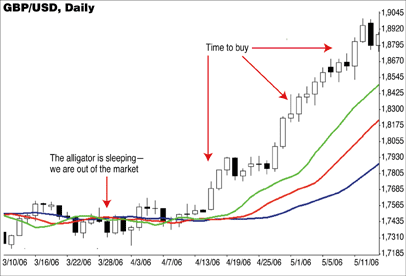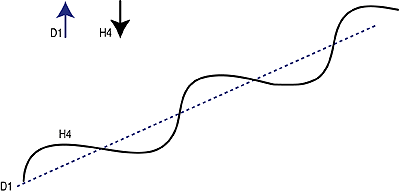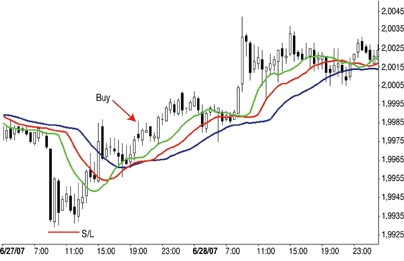The Alligator Indicator
Here's a trading system you can apply to trending markets such as the currencies.
There is a moving average-based trading system that I have found works best in trending markets, with its main instrument the alligator indicator. The alligator was first described by Bill Williams in his book New Trading Dimensions. Some software packages include the alligator indicator, but if it's not available, all you have to do is take three smoothed moving averages using 13, eight, and five periods and shift them by eight, five, and three bars into the future. The longest period line is blue (the alligator's jaw), the middle one is red (the alligator's teeth), and the shortest one is green (the alligator's lips).
According to Williams, when these three moving averages are twisted together, it means the alligator indicator rests, and so we also rest. But the longer the alligator sleeps, the hungrier it is. So when the alligator awakes after a good, long rest it is very hungry to hunt for food. And its food is price.
Your challenge is to keep company with this animal and hunt with it;
otherwise, you yourself risk being eaten. When all three lines are aligned,
going up one after another with the green being greater than red being
greater than blue, prices are in an uptrend. You need to look into the
possibility of buying. In the event they move down, with the green being
less than the red being less than blue, then you'll be looking into the
possibility of selling since it indicates a downtrend. If moving averages
are entwined, then it is best to be out of the market (Figure 1).

FIGURE 1: THE ALLIGATOR. When the alligator is sleeping, it's best to stay out of the market. When it wakes up is when you should tackle the market with it.
THE TRADING SYSTEM
1. D1 time frame indicates the direction of signals. With the naked eye you can see that prices do not move in a straight line but rather in peaks and troughs. In other words, trends move in waves.
Charles Henry Dow in his Dow theory identified three trend categories: primary, secondary, and minor. The primary tendency is similar to the flow. The secondary resembles waves that constitute flow. The minor trends look like ripples.
The trend is presented in the D1 (daily) time frame as a flow. This means that your aim is to find a wave inside the flow that is moving in a different direction in order to identify a useful entry point. And because of this we use the H4 time frame. At this scale you are waiting for the alligator moving against the day signal.
2. If D1 is in an uptrend, then you need to wait for the downtrend on H4 (four hours). If D1 is in a downtrend, then you must wait for the uptrend on H4. You need to wait for a good entry along the trend (Figure 2). For this reason we use the M30 (30-minute) time frame. Suppose that on the daily chart the alligator looks upward. The next step is to wait for the downward wave on H4. And when the alligator gives a buy signal, after the moving averages cross over and are trending higher, you would enter a long position. The trade system has finished configuration:

FIGURE 2: WAITING FOR A GOOD ENTRY. If D1 is in an uptrend, then you need to wait for the downtrend on H4 (four hours). If D1 is in a downtrend, then you would wait for the uptrend on H4.During the buy or sell signal setup, you are waiting for a precise and reliable moving average crossover. Now you could look at the closing price of the candle. If there is a crossover at closing time, you have a signal. In the event the moving average crossover did not happen, you would have to wait for the next closing price. Once you have opened a position, the best area to place a stop-loss is over the price pivot (Figure 3).

FIGURE 3: PLACING THE STOP-LOSS. Here is the stop-loss at the red line, or the alligator's teeth. This line reflects the price pivot.
To define the price target I tend to look at some of the more classic technical analysis. Essentially, we are looking at important resistance and support levels or we wait for a trend reversal or the start of a correction. This means a reversal price pattern or a divergence with price at oscillators. The direction and target of the signals are derived from the lag by the longest of three time frames in this trading system.
FOLLOW THE ALLIGATOR
Like all the moving averages, the alligator is a lagging indicator. Such a lag in getting a trade signal leads to a partial loss of profit. Further, this lag functions as a filter and helps eliminate insignificant and false signals.
In testing the alligator indicator, I have found that hunting hand in hand with the alligator works better than all the other moving average crossover systems I have used. The alligator trading system yielded the lowest losses in unfavorable market conditions of all the moving average crossover systems.
Alexander Sabodin is a consultant for ForexLine in Belarus. He may
be reached at www.fxline.by.
Suggested reading:Gopalakrishnan, Jayanthi [2007]. “Profitunity Home Study Course,” Quick-Scan, Technical Analysis of Stocks & Com-modities, Volume 25: August.
Williams, Bill [1998]. New Trading Dimensions: How To Profit From Chaos In Stocks, Bonds, And Commodities, John Wiley & Sons.
Originally published in the January 2008 issue of Technical Analysis
of
STOCKS & COMMODITIES magazine. All rights reserved. © Copyright
2007, Technical Analysis, Inc.
Return to January 2008 Contents